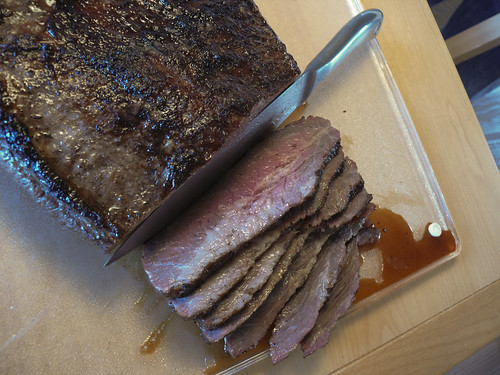But last year home-preserved meats became a subject of some fascination, and I'm not entirely sure why or how, but we got it into our heads that we should be able to corn our own beef.
Dan and I have done four of them now, and I am happy to report that we are able to replicate success. Each has been delicious, and each a bit different because we've experimented with preparation methods.

Our most recent brisket was a flat (or first) cut with a really nice vein of fat through the center and some fantastic marbling. I trimmed all of the external fat from it so that the dry rub could work its magic. We grilled this one over low heat (around 300 degrees) in a kettle drum smoker with some hickory chunks on the coals, fat side down first and then turning it after the fat side was seared. It came out the consistency of prime rib.

You'll note that aside from the medium-rare inside, the meat is a more traditional gray-brown and not the bright pink often associated with corned beef. My son has a friend who can't eat nitrates, and so one of the first things I did was look for a recipe that didn't include the saltpetre. Saltpetre is what gives the corned beef its unnaturally pink color, and believe me, you don't miss the flavor one bit.
Here's the corned beef recipe. We served the grilled brisket with my Meat Sauce, and after first helpings of just meat with sauce, we all went back for sandwiches on artisan rolls with provolone and whole-grain mustard.
For a more traditional preparation method:
Peel and quarter 4 red potatoes (waxy potatoes only!)
Prepare a corned beef according to the recipe, but omit the final overnight soaking step. In a stockpot large enough to hold the entire brisket, brown 4 slices of bacon cut into 1-inch pieces until the fat has rendered out. To the bacon fat, add one large coarsely chopped yellow onion and four smashed cloves of garlic and sweat until the onions are translucent. Put the brisket in the pot and then cover with dark beer (cheap dark beer like Michelob Dark will do, but I used Redhook Copperhook). Add a bay leaf, bring to a boil, reduce to a simmer, and cover. Check every 30 minutes or so and add boiling water if the liquid level is getting too far below the meat. After the pot has boiled for a minimum of two hours, check the meat for doneness. If it's falling apart, remove it to a large serving dish (it's okay if chunks stay in the liquid).
Increase the heat to high, add the potatoes, and boil the liquid until it reduces by about one third and the potatoes are soft (about 20 minutes). Taste a spoonful and add salt and pepper to taste. Do not salt the liquid until this point! You have no idea just how much salt a dry-cured brisket will give up during cooking. Remove the potatoes with a slotted spoon and add to the beef in the serving dish.
Next, ladle about 1 C of the pan liquid into a bowl, chill with an ice cube, and then stir in 1/3 C flour. When the flour is dissolved, pour the flour mixture back into the pan liquid and whisk until the mixture thickens. Finally, apply your stick blender to the pan liquid until you have a slightly chunky gravy. Garnish with parsley or other appropriate fresh herbs and serve over your brisket.
No comments:
Post a Comment